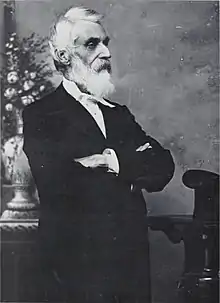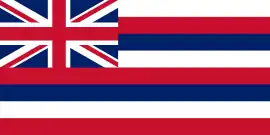Walter M. Gibson | |
|---|---|
 Photo of Walter M. Gibson | |
| Prime Minister of Hawaii | |
| In office May 20, 1882 – June 30, 1887 | |
| Monarch | Kalākaua |
| Preceded by | William Lowthian Green |
| Succeeded by | Position Vacant |
| Minister of Foreign Affairs | |
| In office May 20, 1882 – June 30, 1886 | |
| Monarch | Kalākaua |
| Preceded by | William L. Green |
| Succeeded by | Robert J. Creighton |
| Minister of the Interior | |
| In office June 30, 1886 – October 13, 1886 | |
| Monarch | Kalākaua |
| Preceded by | Charles T. Gulick |
| Succeeded by | Luther Aholo |
| Minister of Foreign Affairs | |
| In office October 13, 1886 – July 1, 1887 | |
| Monarch | Kalākaua |
| Preceded by | Robert J. Creighton |
| Succeeded by | Godfrey Brown |
| Personal details | |
| Born | Walter Murray Gibson January 16, 1822 At sea, Atlantic Ocean |
| Died | January 21, 1888 San Francisco, California |
| Resting place | Hawaii |
| Nationality | Kingdom of Hawaii, American |
| Political party | National |
| Spouse | Rachel Lewis Gibson (m. 1838) |
| Children | 3 |
| Signature | |
Walter Murray Gibson (January 16, 1822 – January 21, 1888) was an American adventurer and a government minister in the Kingdom of Hawaii prior to the kingdom's 1887 constitution.
Early life
Gibson was born January 16, 1822, at sea between Gibraltar and England.[1] He was christened on March 6 in England in Stamfordham, Northumberland,[2] though he sometimes claimed to have been born in England.[3] As a young man, he taught a school in Elbert County, Georgia, though the land later became a part of Hart County, Georgia. He spent his young adulthood in Anderson District, South Carolina.[4] He was the captain of a ship and became involved in gunrunning in the Caribbean.[5] Later, he was jailed in the East Indies by the Dutch on charges of fomenting rebellion, was sentenced to death,[4] but managed to escape from Weltevreden Prison[4] in Java. He claimed receiving a vision while in prison to "build up a kingdom in these isles, whose lines of power shall run around the earth."[6][7] In 1859, he went to Utah Territory and joined the Church of Jesus Christ of Latter-day Saints (LDS Church), persuading church president Brigham Young to allow him to establish a Mormon colony in the Pacific.[8]
LDS Church colony
Gibson arrived in the Hawaiian Islands in 1861, and founded a colony among members of the LDS Church who were already in the islands. He purchased land on the island of Lanai with funds from the colony in his own name, but was excommunicated after an investigation by the church regarding accusations of preaching false doctrine, maladministration of the colony,[9] and embezzlement of church funds.[5] The proceedings leading to his excommunication were initiated by letters from Jonathan Napela and other Native Hawaiian church leaders to church headquarters in Salt Lake City. Upon excommunication, he expelled those who did not support him from his colony and church[10] and began angling for secular political office and power.
Political career

In 1873, Gibson started his own newspaper to extol his virtues in English and Hawaiian called the Nuhou. He successfully ran for the House of Representatives in 1878[11] as a candidate of the King's Party, allying himself with King Kalakaua and portraying himself as the "voice of Hawaiians". In 1880 he bought the Pacific Commercial Advertiser (forerunner to the Honolulu Advertiser).[12]
In 1882, he was appointed Minister of Foreign Affairs, and then in May of 1882, Prime Minister of the Kingdom of Hawaii by King Kalākaua. He also served on various boards, as Attorney General, Minister of the Interior, and Secretary of War.[11] He often held several cabinet positions simultaneously, and at one point, the cabinet consisted of only him and Minister of Finance John Mākini Kapena, resulting in newspapers labeling him the "Minister of Everything".[13][14]
Gibson was widely credited with encouraging Kalākaua to make rash political moves, which eventually led to the imposition of the 1887 Constitution of the Kingdom of Hawaii. One of his bolder plans included an attempt to build a Pacific empire, which drew the ire of both the international and local Hawaiian communities.[5] Sending the "homemade battleship" Kaimiloa to Samoa in 1887 resulted in suspicions from the German Navy and embarrassment for the conduct of the crew.[6]
Personal life
On July 10, 1838, the sixteen-year old Gibson married the twenty-year old Rachel Margaret Lewis (1818–1844), daughter of Jesse and Hannah Lewis. Prior to their marriage, Gibson had been a boarder with the Lewises in their home in Sandy Springs, outside of Pendleton, South Carolina. They had three children: John Lewis (1838–1877), Henry (died 1893) and Tallulah (later changed to the Hawaiianized Talula, 1843–1903), who married Sheriff of Maui Frederick H. Hayselden. Rachel died in 1844, possibly from the cold conditions of the family's cabin floors or complications from her last pregnancy.[15][16]
Death
Gibson's fortunes fell dramatically after being removed from power in 1887. He fled the islands for fear of his life and died penniless in San Francisco on January 21, 1888. His body was returned to Hawaii for a funeral and burial.[5]
Legacy
According to Samuel W. Taylor, Gibson was a brilliant, audacious imposter who manipulated the LDS Church and Brigham Young to his own advantage. Young named him as missionary-at-large to convert Japan and other Pacific islands. He had some success in Hawaii but was excommunicated by Young. He then turned to politics becoming Hawaii's chief minister. He plotted the revolution of 1887, but was overthrown and saved from execution by a British diplomat.[17]
In film
Sam Neill played Gibson in the 1999 film Molokai: The Story of Father Damien.
References
- ↑ Jenson, Andrew (1936). Latter-day Saint Biographical Encyclopedia. Vol. 4. Salt Lake City: Andrew Jenson Memorial Association. p. 339.
- ↑ England, Northumberland, Parish Registers, 1538-1950", database with images, FamilySearch (https://www.familysearch.org/ark:/61903/1:1:CS74-KLPZ : 5 November 2020), Walter Murray Gibson, 1822.
- ↑ James Warren Gould (1960). "The Filibuster of Walter Murray Gibson". Annual report of the Hawaiian Historical Society. Hawaii Historical Society. pp. 7–32. hdl:10524/56.
- 1 2 3 "The Case of Captain Gibson". New York Times. May 31, 1854.
- 1 2 3 4 Will Hoover, "Walter Murray Gibson", Honolulu Advertiser, 2006-07-02
- 1 2 McBride, Spencer. "Mormon Beginnings in Samoa: Kimo Belio, Samuela Manoa and Walter Murray Gibson". Brigham Young University. Retrieved May 24, 2020.
- ↑ Walter M., Gibson (February 24, 1861). "Walter Murray GIBSON letter 1861 to Brigham YOUNG from San Bernardino, California Call Number CR 1234 1". Church Historians Office. Letter to Brigham Young. Salt Lake City: Gibson Name File.
- ↑ Andrade 1996, p. 11.
- ↑ Gibson was reportedly selling leadership positions in the church to native Hawaiians.
- ↑ Sometimes referred to as the "Church of Jesus Christ of Latter Day Saints (Gibsonite)" or the "Gibsonite Mormons".
- 1 2 "Gibson, Walter Murray office record". state archives digital collections. state of Hawaii. Retrieved March 20, 2010.
- ↑ Bob Krauss (August 22, 2004). "Advertiser boasts a storied history". Honolulu Advertiser.
- ↑ Hamilton 2017, p. 141.
- ↑ Adler & Kamins 2019.
- ↑ Adler & Kamins 2019, pp. 7–11, 218.
- ↑ Kuykendall 1967, p. 363.
- ↑ Taylor, 1964.
Bibliography
- Adler, Jacob; Kamins, Robert M. (2019) [1986]. The Fantastic Life of Walter Murray Gibson: Hawaii's Minister of Everything. Honolulu: University of Hawaii Press. ISBN 978-0-8248-8366-9. OCLC 1126516674.
- Andrade, Ernest (1996). Unconquerable Rebel: Robert W. Wilcox and Hawaiian Politics, 1880–1903. Niwot, CO: University Press of Colorado. ISBN 978-0-87081-417-4. OCLC 247224388.
- Kuykendall, Ralph Simpson (1967). The Hawaiian Kingdom 1874–1893, The Kalakaua Dynasty. Vol. 3. Honolulu: University of Hawaii Press. ISBN 978-0-87022-433-1. OCLC 500374815.
- Hamilton, Richard F. (July 5, 2017). America's New Empire: The 1890s and Beyond. Routledge. ISBN 9781351532174.
- Taylor, Samuel W. "Walter Murray Gibson: Great Mormon Rascal" American West (00031534). (1964) 1#2 pp 18–28.
Further reading
- Walter M. Gibson (1855). The prison of Weltevreden: and a glance at the East Indian Archipelago. J. C. Riker.
- Walter M. Gibson (1881). Sanitary Instructions for Hawaiians.
- Tate, Merze (1960). "Hawaii's Program of Primacy in Polynesia". Oregon Historical Quarterly. Oregon Historical Society. 61 (4): 377–407. JSTOR 20612586.
External links
 Media related to Walter M. Gibson at Wikimedia Commons
Media related to Walter M. Gibson at Wikimedia Commons- All about Hawaii. The recognized book of authentic information on Hawaii, combined with Thrum's Hawaiian annual and standard guide ((original from University of Michigan)). Honolulu Star-Bulletin. 1891. pp. 92–97 – via HathiTrust.
- "A List of All the Cabinet Ministers Who Have Held Office in the Hawaiian Kingdom"
- Woods, Roberta. "LibGuides: Hawai'i Legal Research: Attorney General Opinions". law-hawaii.libguides.com.
- Includes a list of Attorneys General for the Kingdom of Hawaii, their salaries and budgets
